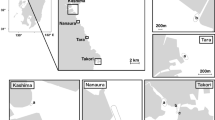Abstract
Horseshoe crabs are said to be declining worldwide. However, there is still no published report on the status of horseshoe crabs in Malaysia. Thus, we report here eight informative microsatellite markers that were developed using the 5′-anchored ISSR-PCR enrichment procedure to diagnose the population genetic structure of the mangrove horseshoe crab, Carcinoscorpius rotundicauda from Peninsular Malaysia. This set of markers was tested on 127 samples and showed polymorphism in this species. Hence they should be useful in future essential population genetic studies of these living fossils in the Southeast Asian region.

Similar content being viewed by others
References
Sekiguchi K (1988) III Biogeography. In: Sekiguchi K (ed) Biology of horseshoe crabs. Science House, Tokyo, pp 22–49
Morton B (1999) On turtles, dolphins and, now, Asia’s horseshoe crabs. Mar Poll Bull 38:845–846
Botton ML (2001) The conservation of horseshoe crabs: what can we learn from the Japanese experience? In: Tanacredi JT (ed) Limulus in the limelight. Kluwer Academic/Plenum, New York, pp 41–51
Chiu HMC, Morton B (2003) The status of horseshoe crabs in Hong Kong. In: Morton B (ed) Perspectives on marine environmental change in Hong Kong and Southern China. In: Proceedings of the Hong Kong workshops reunion conference on perspectives on marine environmental change in Hong Kong and Southern China (1977–2001). Hong Kong University Press, Hong Kong, pp 743–758
Chen CP, Yeh HY, Lin PF (2004) Conservation of the horseshoe crab at Kinmen, Taiwan: strategies and practices. Biodivers Conserv 13:1889–1904
Berkson J, Shuster CN Jr (1999) The horseshoe crab: the battle for a true multiple-use resource. Fisheries 24:6–12
Walls EA, Berkson J, Smith SA (2002) The horseshoe crab, Limulus polyphemus: 200 million years of existence, 100 years of study. Rev Fish Sci 10:39–73
Winnepennincks B, Backeljau T, Wachter RD (1993) Extraction of high molecular weight DNA from mollusks. Trends Genet 9:407
Hoh BP, Siraj SS, Tan SG, Yusoff K (2008) Isolation of trinucleotide microsatellite markers for Mystus nemurus. Russ J Genet 44:369–371
Rozen S, Skaletsky HJ (2000) Primer 3 on the WWW for general users and for biologist programmers. In: Krawetz S, Misener S (eds) Bioinformatics methods and protocols: methods in molecular biology. Humana Press, Totowa, pp 365–386
Van Oosterhout C, Hutchinson WF, Wills DPM, Shipley P (2004) MICRO-CHECKER: software for identifying and correcting genotyping errors in microsatellite data. Mol Ecol Notes 4:535–538
Lewis P O, Zaykin D (2002). Genetic data analysis (GDA): computer program for the analysis of allelic data, version 1.1. http://lewis.eeb.uconn.edu. Accessed 23 Jan 2011
Miller M P (1997) TFGPA—tools for population genetic analyses: program for the analysis of allozyme and molecular population genetic data, v. 1.3 (distributed by the author by contacting: mpm2@jan.ucc.nau.edu), Flagstaff, AZ
Reddy M P, Sarla N, Neeraja CN, Siddiq EA (2000). Assessing genetic variation among Asian A-genome Oryza species using inter simple sequence repeat (ISSR) polymorphism. In: Fourth international rice genetics symposium 22–27 October 2000. IRRI, Philippines, p. 212 (Abstracts)
Blair MW, Panaud O, McCouch SR (1999) Inter-simple sequence repeat (ISSR) amplification for analysis of microsatellite motif frequency and fingerprinting in rice (Oryza sativa L.). Theor Appl Genet 98:780–792
Joshi SP, Gupta VS, Aggarwal RK, Ranjekar PK, Brar DS (2000) Genetic diversity and phylogenetic relationship as revealed by inter-simple sequence repeat (ISSR) polymorphism in the genus Oryza. Theor Appl Genet 100:1311–1320
Nagaoka T, Ogihara Y (1997) Applicability of inter-simple sequence repeat polymorphisms in wheat for use as DNA markers in comparison to RFLP and RAPD markers. Theor Appl Genet 94:597–602
Acknowledgment
This work was supported by grant No. 05/01/07/0220RU (91220) from Universiti Putra Malaysia.
Author information
Authors and Affiliations
Corresponding author
Electronic supplementary material
Below is the link to the electronic supplementary material.
Rights and permissions
About this article
Cite this article
Adibah, A.B., Ling, L.P., Tan, S.G. et al. Development of single-locus DNA microsatellite markers using 5′anchored ISSR-PCR method for the mangrove horseshoe crab, Carcinoscorpius rotundicauda (Latreille, 1802) in Peninsular Malaysia. Mol Biol Rep 39, 3815–3820 (2012). https://doi.org/10.1007/s11033-011-1159-6
Received:
Accepted:
Published:
Issue Date:
DOI: https://doi.org/10.1007/s11033-011-1159-6




